Purpose
This permit section focuses on mitigating stormwater impacts from new and re-development by requiring practices that treat, store, and infiltrate stormwater onsite. Towns should use the minimum disturbance size they normally regulate (whether it's 0.5 acres per the Erosion Sediment Control Act or smaller if your town uses a lower threshold) for the stormwater retention standards in this section.
Relevant Terms
Redevelopment: means any construction activity (including, but not limited to, clearing and grubbing, grading, excavation, and dewatering) within existing drainage infrastructure or at an existing site to modify or expand or add onto existing buildings or structures, grounds, or infrastructure.
Low impact development (LID): means a site design strategy that maintains, mimics, or replicates pre-development hydrology through the use of numerous site design principles and small-scale treatment practices distributed throughout a site to manage runoff volume and water quality at the source.
Runoff reduction practices: means those post-construction stormwater management practices used to reduce post-development runoff volume delivered to the receiving water, as defined by retaining the volume of runoff from a storm up to the first half inch or one inch of rainfall in accordance with sections 6(a)(5)(B)(i) or (ii) respectively. Runoff reduction is quantified as the total annual post-development runoff volume reduced through canopy interception, soil amendments, evaporation, rainfall harvesting, engineered infiltration, extended filtration or evapotranspiration.
Water Quality Volume (WQV): means the volume of runoff generated by one inch of rainfall on a site as defined by the Connecticut Stormwater Quality Manual.
Resources
Low Impact Development
Tools for reviewing and updating municipal regulations
- Developing a Sustainable Community by CT NEMO. An easy to use guide to help Connecticut communities craft plans and regulations that promote Low Impact Development and protect water quality.
- LID Site Planning and Design Techniques: Municipal Self Assessment by RI NEMO. A comprehensive step-by-step guide for reviewing municipal regulations
- Code and Ordinance Worksheet (COW) by the Center for Watershed Protection. A tool to help communities evaluate their local development regulations to identify revisions that allow (or require) site developers to minimize impervious cover, conserve natural areas and use runoff reduction practices to manage stormwater runoff.
- Bylaw Review Tool by Mass Audubon. This tool incorporates best practices from local, regional, state, and federal best practices and provides allows users to evaluate existing land use regulations in comparison to these best practices in a “conventional,” “better,” and “best” format in relation to over 30 considerations (such as street width, erosion control measures, sidewalk drainage, and more).
- Code Review Spreadsheet for MS4 communities by the Pioneer Valley Planning Commission. This checklist can be used as a method of documenting review of existing local code for requirements that affect the creation of impervious cover and feasibility of allowing green infrastructure and it contains some notes and recommendations for potential policy and language changes.
Tools for reviewing site plans
- CT NEMO sample LID checklist for site plans.
- Town of Vernon LID checklist for review of development applications to the Planning & Zoning Department.
LID Guides
- The Practice of Low Impact Development from the U.S. Dept. of Housing and Urban Planning. This guide provides an introduction to what LID is and LID practices that can be integrated into the daily practices of land developers.
LID Design templates
- Tree well designs from the Town of East Lyme.
- 15'x 5' Bioswale design from the City of New Haven.
- Bioswale cross section from the City of New Haven.
- CT NEMO's Rain Garden App and website.
Tools for Maintaining LID
- Stormwater wet pond and wetland management guidebook provides detailed guidance on how to maintain stormwater ponds.
- In the Weeds: A Guide for Maintaining Vegetation in Stormwater Treatment Systems in Rhode Island developed by the University of Rhode Island. They also created an app version of this guide which you can get here.
- Long-term Maintenance Plan for LID Installations on Town Property from the Town of Mansfield.
- Opti-Tool and BMP Accounting and Tracking Tool by EPA Region 1. These tools help practitioners and permit holders calculate pollution removal from post-construction green infrastructure practices.
-Operation and Maintenance of Green Infrastructure Receiving Runoff from Roads and Parking Lots by EPA. This memorandum addresses common operation and maintenance questions and provides recommendations for evaluating the need and providing maintenance for green infrastructure, specifically bioretention and bioswales, that serves highly impervious roadways and parking lots.
- Green Infrastructure Operations and Maintenance page by EPA. This provides access to maintenance manuals for rain gardens, biorientation areas, porous pavement, and more.
Examples
Connecticut Municipalities
- Barkhamsted LID-amended regs & ordinances
New England Examples
- Is Your Community Climate Resilient? – Bylaws and Best Practices by SNEP Network. This webinar explores the Mass Audubon Bylaw Review Tool and other resources included Mass Audubon, EPA Region 1, the Cape Cod Commission, the Southeast Regional Planning and Economic Development District, and the Blackstone Watershed Collaborative.
- Green Infrastructure Plan by Pioneer Valley Planning Commission. The plan identifies the three existing infrastructures (stormwater, combined sewers, and roads) where green infrastructure might best be integrated; describes useful criteria for mapping potential green infrastructure facility locations; explores important opportunities and challenges; and proposes workable strategies for local and regional actions that will help to address polluted stormwater flows and meet forthcoming stormwater permit requirements.
- Assessing Street and Parking Design Standards to Reduce Excess Impervious Cover in New Hampshire and Massachusetts by EPA. This assessment will be used to determine if design standards need to be revised to support the application of Low Impact Development (LID) techniques.
- National Menu of Best Management Practices (BMPs) for Stormwater Post-Construction by EPA. This recently-released resource includes many green infrastructure practices.
For additional resources and New England Programs involved in green infrastructure, visit: https://www.epa.gov/soakuptherain/local-organizations-help-you-soak-rain
Directly Connected Impervious Area (DCIA)
Tracking DCIA
- DCIA tracking spreadsheet developed by CT NEMO long ago.
DCIA tutorial
- This video explains all things DCIA in the MS4 permit:
Off-Site Stormwater Management
- EPA has released a new webpage dedicated to off-site stormwater management.
Minimum Control Measure 5 of the permit requires:
-
- New development and redevelopment sites with less than 40% DCIA must retain the water quality volume for the site
- Redevelopment sites with 40% DCIA or more, the site must retain on-site half of the water quality volume
- If sites are unable to retain the required amount of water quality volume, developers must implement an off-site mitigation project to retain the remaining water quality volume OR
- Pay a “fee in lieu of” equal to the cost of implementing a retrofit project to retain the remaining water quality volume
This website offers numerous resources for off-site stormwater management, such as stormwater financing webinars, examples of retention crediting programs, retrofit manuals, and more.
Task list
Where the deadline for new MS4 permittees differs from the deadline for exisiting permittees, the second deadline in parenthesis applies to new permittees.
| Activity | Deadline | Permit Page |
|---|---|---|
| Maintenance plan for stormwater ponds and treatment structures | Jul 1 2019 (Jul 1 2020) |
30 |
| Determine baseline DCIA | Jul 1 2020 | 30 |
| Review regulations for LID barriers | Jul 1 2021 (Jul 1 2022) |
27 |
| Establish legal authority for site stormwater retention standards | Jul 1 2021 (Jul 1 2022) |
27 |
CT MS4 December Disconnection Workshop Materials
The NEMO program presented a virtual workshop series on the impervious cover disconnection portions of the MS4 Permit during December 2020. The presentation slides and recordings can be found below.
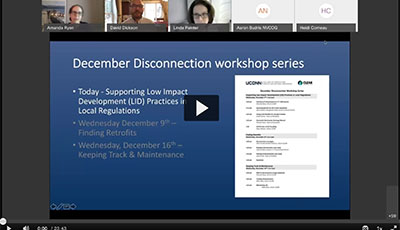
Summary of LID provisions in CT’s MS4 permit
December 1st, 2020
Presented by: Amanda Ryan, UConn CLEAR
UConn CLEAR's Amanda Ryan presents on the requirements in the CT MS4 General Permit to review and amend local land use regulations to encourage the use of LID. Presented on Dec 2, 2020 as part of the December Disconnection Workshop Series.
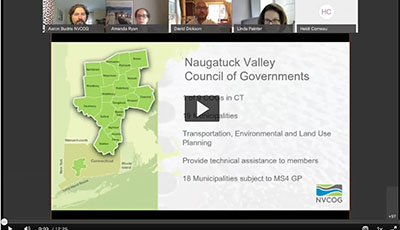
Assessing barriers to LID in local regulations
December 2nd, 2020
Presented by: Aaron Budris, NVCOG
Aaron Budris, Senior Planner with the Naugatuck Valley Council of Governments (NVCOG), presented on a project that reviewed the regulations of their member towns and made recommendations for how they could promote the use of LID. Presented on Dec. 2, 2020 as part of the December Disconnection Workshop Series.
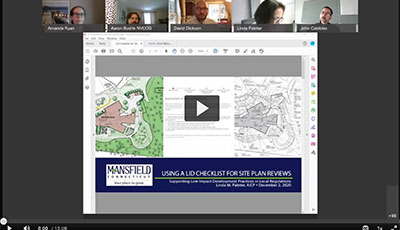
Using a LID Checklist for site plan reviews
December 2nd, 2020
Presented by: Linda Painter, Town of Mansfield
Linda Painter, Town of Mansfield Planner, presentation on Mansfield's LID checklist. Presented on Dec. 2, 2020 as part of the December Disconnection Workshop Series.
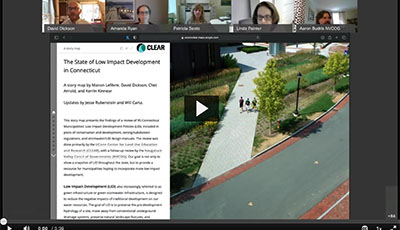
CLEAR State of LID StoryMap
December 2nd, 2020
Presented by: Dave Dickson, UConn CLEAR
Dave Dickson UConn CLEAR, presents on how to use the State of LID Story Map to find examples of LID friendly regulation language. Presented as part of the December Disconnection Workshop Series on Dec 2, 2020.
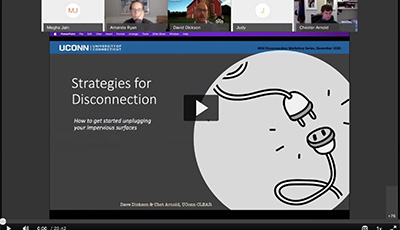
Disconnection Strategies
December 9th, 2020
Presented by: Dave Dickson and Chet Arnold, UConn CLEAR
Dave Dickson and Chet Arnold, UConn CLEAR, present on developing a strategy for disconnecting 1% of impervious cover per year. Presented on Dec. 9, 2020 as part of the December Disconnection Workshop Series.
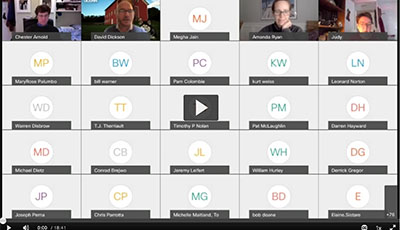
Roadway Disconnection case study
December 9th, 2020
Presented by: Judy Rondeau, Eastern CT Conservation District
Judy Rondeau, Assistant Director of the Eastern Connecticut Conservation District, presented on a project to use tree wells and tree box filters to disconnect roadways from the stormwater system. Presented on Dec. 9, 2020 as part of the December Disconnection Workshop Series.
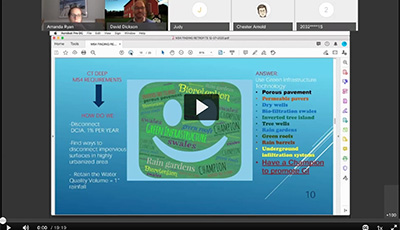
Parking lot disconnection case study
December 9th, 2020
Presented by: Laura Pulie, Town of Fairfield, CT
Laura Pulie, Town of Fairfield Senior Civil Engineer, presented about a project to install pervious pavement at a commuter parking lot in Fairfield. Presented on Dec. 9, 2020 as part of the December Disconnection Workshop Series. Presented on Dec. 9, 2020 as part of the December Disconnection Workshop Series.
MS4 2% Disconnection Goal Explained
December 9th, 2020
Presented by: Amanda Ryan, UConn CLEAR
Presentation by UConn CLEAR's Amanda Ryan introducing impervious cover disconnection requirements and tracking. Part of the December 2020 Disconnection Workshop Series.
Tracking Disconnections
December 9th, 2020
Presented by: Mike Dietz, UConn CLEAR
Presentation by UConn CLEAR's Dr. Michael Dietz about a impervious cover disconnection tracking template available at https://nemo.uconn.edu/ms4. Part of the December 2020 Disconnection Workshop Series.
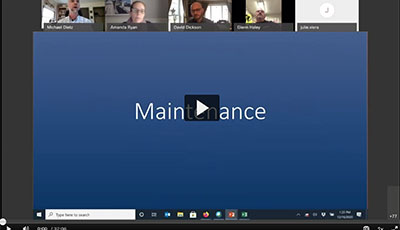
Maintaining LID
December 9th, 2020
Presented by: Mike Dietz, UConn CLEAR and Glenn Haley, UConn
Presentation by UConn CLEAR's Dr. Michael Dietz and UConn's Glenn Haley about lessons learned from maintaining low impact development/green stormwater infrastructure (LID/GSI) practices on the UConn Campus. Part of the December 2020 Disconnection Workshop Series.